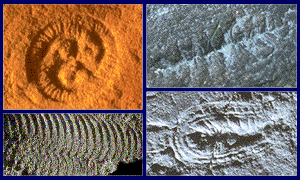Introduction to the Vendian Period
650 to 543 Million Years Ago
 |
When Charles Darwin wrote On the Origin of Species, he and most paleontologists believed that the oldest animal fossils were the trilobites and brachiopods of the Cambrian Period, now known to be about 540 million years old. Many paleontologists believed that simpler forms of life must have existed before this but that they left no fossils. A few believed that the Cambrian fossils represented the moment of God's creation of animals, or the first deposits laid down by the biblical Flood. Darwin wrote, "the difficulty of assigning any good reason for the absence of vast piles of strata rich in fossils beneath the Cambrian system is very great," yet he expressed hope that such fossils would be found, noting that "only a small portion of the world is known with accuracy."
Since Darwin's time, the fossil history of life on Earth has been pushed back to 3.5 billion years before the present. Most of these fossils are microscopic bacteria and algae. However, in the latest Proterozoic — a time period now called the Vendian, or the Ediacaran, and lasting from about 650 to 540 million years ago — macroscopic fossils of soft-bodied organisms can be found in a few localities around the world, confirming Darwin's expectations.
|
Click on the buttons below to learn more about the Vendian. 

 |
 |
UCMP Special Exhibit: Vendian Animals Ben Waggoner has worked extensively with the troublesome creatures of the Vendian. You can learn about these earliest animals in his exhibit. |
Much of the Vendian work done by UCMP was supported by NSF EAR grants numbers 9317247 and 9814845 to J.W. Valentine and J.H. Lipps.
